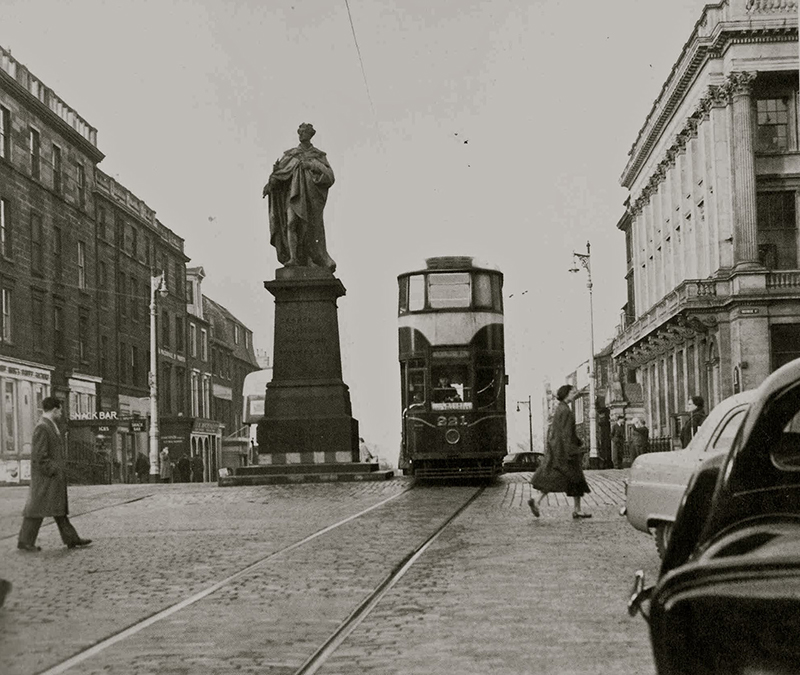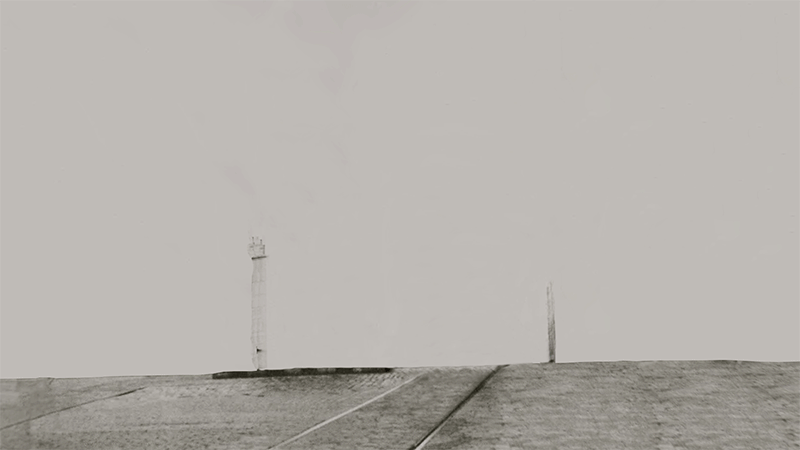The Living Pictures Project
Winding back the clock in Auld Reekie.
- Client: Personal Project
- Brand: Pixel Theatre
Categories
Wow, miraculous. I just had a magical 1 munute out-of-body experience! Thank you for creating this.Will Smail
Edinburgh's intriguing roots
Many of us who live in Edinburgh are fans of a Facebook group called Lost Edinburgh. It is a group that was set up over 9 years ago to share pictures of Edinburgh from years gone by. We get regular snapshots of how things used to look, the spaces that are now suburbia, what beautiful buildings and industry used to stand in spaces that are now empty or full of modern buildings whose foundations have barely been laid. As Edinburgh is my home town, it gives me a connection to our cities heritage and a sense of where our unique culture and identity came from.
Time travelling cameraman
Snapshots are one thing, but what if I could take my camera back in time and stand next to the original photographer so I could capture some footage of the same scene? So, I decided to become time traveller, and like my trusty companion I'm taking you along for the ride! Ok, so blue telephone boxes are hard to come by these days and I forgot where I parked the DeLorean so I used some well executed movie magic to pull off the feat of winding back the clock.

Choosing our first destination — 1950's
The source images I choose must be suitable for a 16:9 video. The photogrammetry I use allows me a minimum amount of camera movement, not enough to pan down a portrait image but enough to move a little bit within a landscape frame. If it's a wide shot this slight movement still represents a pretty large tracked shot and really pumps up the production value. I'm also restricted based on the quality of the source image. Many of the images I looked at are low resolution or are damaged and require restoration. I can get away with lower quality images to a point, it is synonymous with the period where the clip comes from after all. But I need enough image detail to work my magic in Photoshop and After Effects or it will just turn into pixel soup. Narrowing the field to suitable candidates, I initially chose this image as it prominently features one of the last generation of trams that we used to have all over town. No-one in my circle of friends, nor most my surviving family remembers the time when these trams ruled the city. So, it is a street we all know but with a totally different feel that can pique our sense of wonder.
Using Camera Mapping and Photoshop
I created a basic 3D version of my scene in software and projected the flat image onto the surface of the scene. This is called camera mapping or photogrammetry. By doing this I give the geometry of the scene the exact look of the photograph. As the objects are 3D I can move a camera around them and shift the perspective. The desired effect is achievable so long as the movement of the camera is limited and the camera stays nearby the original vantage point.

To prepare the image for camera mapping I had to take it into Photoshop and do some work on it. First, I tidied up the image, removing marks or blemishes that could easily be stuck on a still but would not linger in film. Detail was invented behind objects so I could see what is behind them as the camera moves position. I didn't want to involve people moving around, so they were removed from the scene. Part of the process involved cutting up the image by the different plains, separating buildings so they could move independently as the perspective shifted.
CGI Assets of Old
It was a must that the tram travelled through the scene as we trucked right to move out its way. To invent the detail of the tram from various sides as it passed by required me to build a 3D asset of the tram. The tram had to cast a largely diffused shadow onto the ground and it had to pick up and reflect details of the surroundings in its glass and paintwork. I had to take all of this into account when building the asset and rendering it into the scene.
CGI Assets of Old

Filters were applied to the shiny CGI images to age them to suitably match the source image, and I added noise, scratches and "tram tracks" to give the typical feel of archived footage.
The last task was to make the shot richer and more immersive with an authentic sounding audio bed. I used various sources to blend together sound effects, focusing particularly on the sound of the rolling tram and the engine of the car in the foreground. I mixed these together with general sounds of a quiet street.
Footage of the 50's exists, rewind further.
I reached out to a journalist and local history aficionado David McLean, who happens to run Lost Edinburgh to see what he thought of the work in bringing one of his featured images to life.
His reaction was hugely positive, but he challenged me to think bolder, and look further back, to a time when there were no film cameras around. A time of the horse and cart and when the steam train was king.
I had another look at images that could work with the same scrutiny for suitability as before. Having a candidate with recognisable features of Edinburgh was also a must. Something I was starting to warm to was the idea of including people in the next shot, but hadn't decided how best to tackle it yet. I knew I couldn't avoid it if I decided to create a series of these moments in time.
There were a few options. With any asset in a scenes I can go three different routes which are as follows:
- CGI — Create a completely computer generated asset in 3D. Animate it and position it wherever in the scene and it will be angled and scaled to match the perspective of the camera.
- Fresh Footage — Commission a shoot to recreate assets of the scene in front of a green screen. Super-impose these assets into the scene. I have to film at the correct angle at the shoot, meaning the assets are largely only suitable for the intended scene.
- Archive Footage — Cut out or rotoscope assets from archive footage of the approximate time period of the photo. This is a fairly easy job if the footage I can use is of good quality. But matching up footage taken at a similar angle, with similar lighting which is not sitting in front of a complicated or patterned background is time intensive.
This is fabulous. It's a work of art putting it all together, and the music is good too.Elizabeth Barrett
Welcome to the 1870's
Just like the proof of concept, I set off with a big chunk of Photoshopping, tidying the image, splitting it up into layers of objects, removing the people, removing the tram and the carriages. I'm replacing all of them with my own assets. Again, I invented detail behind buildings so that our perspective shift revealed something as the camera moves.
A different century, a different tram
In the 1870's Edinburgh had trams that were drawn along by horses. With a Google image search, I went on the hunt for reference photography. Another 3D tram asset was modelled, one that took in its surrounding details and produced accurate reflections. Unusually for Scotland, the sun was out in this scene so I popped in hard shadows this time that cast towards the north in the direct afternoon sunlight. The next part is where things got tricky. I don't have a pet horse. Even if I did, I'd need to get it in front of a green screen and film it walking on a treadmill! So how do I add horses that are pulling an old tram and a carriage though Princes Street? I got a bit lucky with finding a suitable 3D horse model online and I only had to add texture to it and animate its premade skeleton controls. Quadruped animation is pretty tricky though so it took some time to produce a good walk cycle. It was the first time I animated a horse but with plenty of reference material online I quickly created a convincing animation for the shot.
Casting our extras
It got to the point where I had to make a choice on which route to take to add people into the scenes. Any characters that are very close to the screen would be best approached by bringing in actors with green screen. My shots used people a little further away from the camera so I was able to place CGI actors in, I used Adobe Fuse to build up some characters quickly. I did have to create some custom digital threads for the characters as there was a limited pool of choices in Fuse for suitable wardrobe. The shots that are busier required that I delve into the world of crowd simulation to convincingly add the larger groups of people in the later shots in the series. Without a crowd system the crowds would have taken way too long to put together!
Now THATS a beautiful video. I wish I lived in that generation. So much beauty in every thing that was made. So much to be proud of.David Noon
The finishing touches
Like the proof of concept, I used some After Effects magic to age the imagery with a sepia tone, noise, scratches etc. A great selection of sound effects really sold the scene with horse trotting, an audio bed of the open air and birds singing from Princes Street gardens together with the whistle of a steam train from somewhere off by the Waverley.
This project has taken me on a tour through some of Edinburgh's history, and I feel like I have experienced a journey through time. Each clip tells a little story about our fair city and I wonder what other tales are still to be told.
Loved it. Wanted more.Heather Howson
Where do I go from here? Well, other cities seems like an obvious route to go, but I have some other ideas in mind for The Living Pictures Project! Stay tuned!